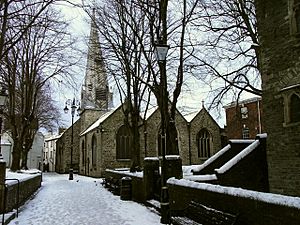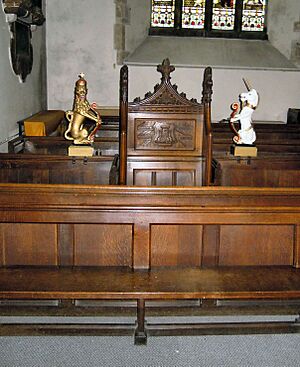St Peter's Church, Barnstaple facts for kids
St Peter's Church is the main church for the town of Barnstaple in North Devon, England. Parts of this historic church are from the 1200s. It was greatly repaired and changed during the Victorian era by famous architects George Gilbert Scott and his son John Oldrid Scott. Even with these changes, many beautiful wall monuments and plaques are still there. The church is part of the Diocese of Exeter.
Contents
A Look Back: The Church's Story
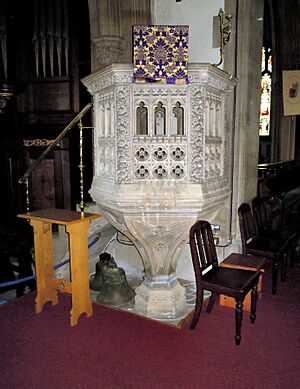
People believe that King Æthelstan gave Barnstaple its first special permission, called a Charter, in 930 AD. A church might have been here even then! The town received more Charters later on. The first known leader of the church, called a Rector, was Walter Treasurer of Exeter in 1257. The first stone church was likely built around that time.
Some parts of the tower and the chancel (the area around the altar) are from the late 1200s. The church was made bigger, probably in 1318. At one point, it had a cross shape, but after the Dissolution of the monasteries (when monasteries were closed), it was changed to a rectangular shape. The church's tall, pointed roof, called a broach spire, was built in the late 1600s. It is considered one of the best of its kind!
Who Owned the Church?
For a long time, the Barnstaple Priory, a type of monastery, owned the church and its rights. This priory was part of the Cluniac order, a group of monks. Old documents show that William the Conqueror gave the Church of Barnstaple to a monastery in France. Later, William Warelwast, who was the Bishop of Exeter, confirmed these gifts to the monks of Barnstaple Priory.
Cool Features Inside the Church
The Dodderidgian Library
The Dodderidgian Library is a special two-story room with wooden windows. It was built in 1667 in the church's north-east corner. This library was started in 1664 by the wife of John Dodderidge. He was a Member of Parliament for Barnstaple and gave his collection of books to the town. The books were moved to the Museum of Barnstaple and North Devon in 1888. Later, in 1957, they were sent to Exeter University Library for safekeeping.
The Mayor's Special Seat
In the north part of the church, there is a special seat for the Mayor of Barnstaple. It looks like a big wooden armchair with cool animal figures on each side. This is where the Mayor would sit during church services.
The Grand Organ
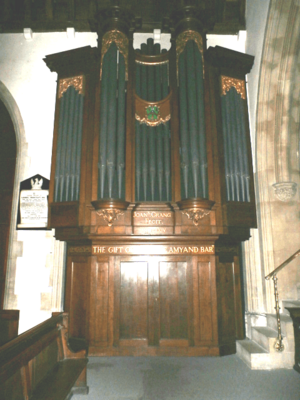
The church has one of the biggest organs in Devon! It was built in 1764 by John Crang. Sir George Amyand, 1st Baronet, who was a Member of Parliament for Barnstaple, gave it to the church. The organ is decorated with his family's coat of arms.
Memorials and Monuments
Inside the church, you can find many monuments on the walls. These are for important merchants from the 1600s. Many of them were also Mayor of Barnstaple. These monuments show how rich and important Barnstaple was as a port town back then. Some of the people remembered here include:
- Elizabeth Delbridge (died 1628), whose husband John Delbridge was a Member of Parliament and Mayor many times.
- A monument from 1634 for the nine-year-old son and other children of Rev Martin Blake. He was the Vicar of Barnstaple and faced difficulties for supporting the King. This monument is very detailed and tells a story through its carvings.
- Richard Beaple (1564-1643), who was Mayor several times. His monument shows a picture of Penrose's Almshouses, which were built in memory of his son-in-law.
- Thomas Horwood (1600-1658), who was Mayor twice.
- Gilbert II Paige (died 1669), whose family has a lane in Barnstaple named after them.
Victorian Changes to the Church
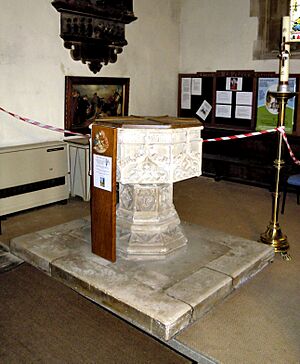
In the early 1800s, galleries (like balconies) were added to the church. This meant many wall memorials were removed. Later, starting in 1866, the church went through a big repair project led by George Gilbert Scott and his son John Oldrid Scott. They removed the galleries, which were considered ugly. However, these changes made the church feel "dark and dull" to some people. Luckily, Scott refused to tear down the old tower, as some had wanted. During these repairs, many old memorials were saved and moved to the Lady Chapel, a special area in the south part of the church. The Lady Chapel itself was repaired in 1911.


